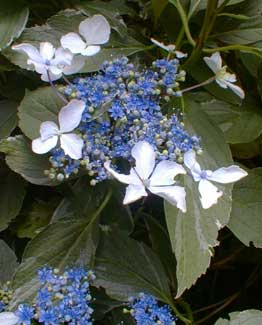
'Mariesii Variegata' aka 'Maculata'
Bigleaf Lacecap Hydrangea
"Newland Archer, standing on the verandah of the house, looked curiously down upon this scene. On each side of the shiny painted steps was a large blue china flower-pot on a bright yellow china stand. A spiky green plant filled each pot, & below the verandah ran a wide border of blue hydrangeas."
-Age of Innocence
by Edith Wharton
(1862-1937)
by Edith Wharton
(1862-1937)
Hydrangea macrophylla 'Mariesii Variegata' bigleaf lacecap hydrangea has lightly variegated leaves, as if someone had taken a fine paintbrush & made a few slim white streaks on each green leaf. It is not necessarily stable, being known sometimes to revert to non-variegated.
Not all hydrangea experts agree it is a variegated sport of the heirloom standard 'Mariesii' & so prefer the alternative name 'Maculata' or simply 'Variegata.'
The early to midsummer blossoms taken with a few leaves still attached are lovely for bouquets. The blooms can also be dried for dry floral arrangements.
This dome-shaped deciduous shrub grows to about five feet tall & six feet wide. If it requires pruning for shape or size, this should be done very soon after the summer flowers are gone, as it sets new buds immediately after flowering. Too much pruning or pruning in the wrong season will reduce or eradicate flowering the following year.
It blooms splendidly in Zone 8 or 9, but in regions with colder winters it will not bloom well because buds freeze off in winter. 'Mariesii Variegata' might still be grown for its foliage. Placement up next to the house may help to preserve some of the buds through winter in Zone 6.
The central tiny fertile florets are a deep gentian blue, & the large sterile petals surrounding the lacecap are a ghostly pale blue. If the color does ever seem to have faded, a light spring feeding of aluminum sulfate will restore the rich blue color.
I vastly prefer lacecap bigleaf hydrangeas to the "hortensia" or snowball or mophead bigleafs. Especially for 'Variegata' it is the small fertile florets that have the best color, & to turn those into giant balls exclusively of sterile petals for my taste is subtracting rather than adding. I find the big snowballs gaudy, while the lacecaps are much more beautiful.
Hydrangea macrophylla is native to Japan, Korea & China, despite that it is sometimes called French Hydrangea after the first great center of hydrangea hybridization in Europe.
This is the species that responds to the trick of alkalinizing soil to get mauve-pink hydrangea blooms, or in neutral soil greenish-white flowers. Variegated shrubs tend to be a little more delicate than non-variegated, & it is my feeling that alkalinizing the soil is not recommendable for 'Mariesii Variegata' because this shrub really prefers acidic soil, has a strong tendency toward blue so does not so perfectly shift color if a change is forced, & the blue is its healthier & more striking color.
It likes filtered sunlight or bright shade in Zone 8, but if attempted in more northern climates it will need more sun. If attempted further south or wherever summers are hot, it needs increasing amounts of shade, as it will quickly wilt on hot days in too much sun. It wants a rich organic moderately moist well-draining soil. 'Mariesii Variegata' is propogated by easily rooted cuttings.